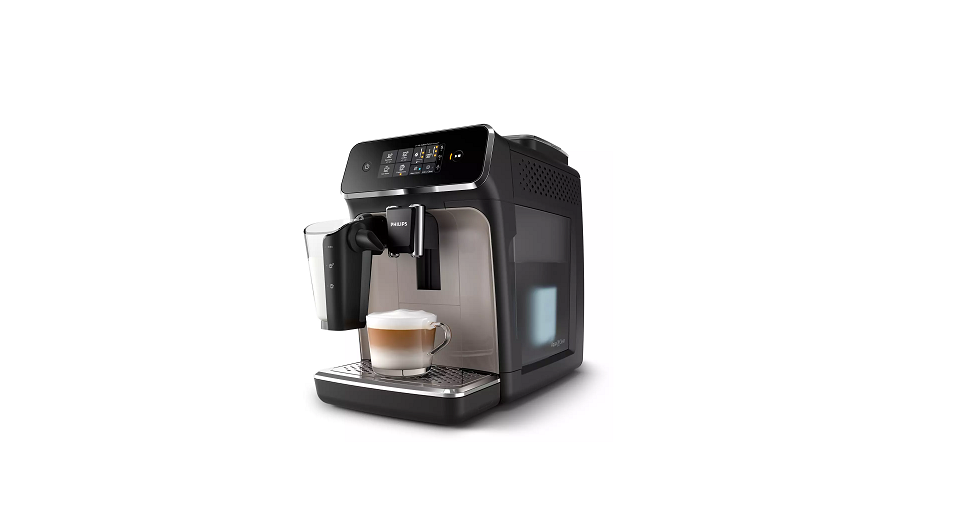Philips 2200 Fully automatic espresso machine User Manual

Machine overview

Control panel

Refer to figure B for an overview of all buttons and icons. Below you find the description.
| B1 | On/off button | B7 | Warning icons |
| B2 | Drink icons* | B8 | Start light |
| B3 | Aroma strength/pre-ground coffee icon | B9 | Start/stop button |
| B4 | Drink quantity icon | B10 | Calc / Clean icon |
| B5 | Milk quantity icon (specific types only) | B11 | AquaClean icon |
| B6 | Coffee temperature icon (specific types only) |
Drink icons: espresso, espresso lungo, coffee, americano, cappuccino, latte macchiato, hot water, steam, iced coffee (specific types only)
Introduction
Congratulations on your purchase of a Philips fully automatic coffee machine! To fully benefit from the support that Philips offers, please register your product at www.philips.com/welcome.
Read the separate safety booklet carefully before you use the machine for the first time and save it for future reference.
To help you get started and to get the best out of your machine, Philips offers support in multiple ways. In the box you find:
- This user manual with picture-based usage instructions and more detailed information on cleaning and maintenance.
There are multiple versions of this espresso machine, which all have different features. Each version has its own type number. You can find the type number on the data label on the inside of the service door (see fig A11) - Theseparate safety booklet with instructions on how to use the machine in a safe
- For online support (frequently asked questions, movies etc.), scan the QR code on the cover of this booklet or visit www.philips.com/coffee-care
The machine automatically adjusts the amount of ground coffee that is used to make the best tasting coffee. You should brew 5 coffees initially to allow the machine to complete its self-adjustment.
Make sure you rinse the Latte Go (milk container) or the classic milk fr other before first use.
Brewing drinks
General steps
- Fill the water tank with tap water and fill the bean hopper with
- Press the on/off button to switch on the
- The machine starts heating up and performs the automatic rinsing During heating up, the lights in the drinks icons light up and go out slowly one by one.
- When all lights in the drink icons light up continuously, the machine is ready for
- Place cup under the coffee dispensing Slide the coffee dispensing spout up or down to adjust its height to the size of the cup or glass you are using (Fig. 1).
Personalizing drinks
This machine allows you to adjust the settings of a drink to your own preference. After selecting a drink you can:
- Adjust the aroma strength by tapping the aroma strength icon (Fig. 2). There are 3 strengths, the lowest is the mildest and the highest is the
- Adjust the drink quantity by tapping the drink quantity (Fig. 3) and/or the milk quantity icon (specific types only). There are 3 quantities: low, medium and high.
Dispensing hot water
- If attached, remove Latte Go or the milk
- Tap the hot water icon (Fig. 15).
- The drink quantity lights go on and show the previous selected drink setting for hot
- Adjust the hot water quantity to your preference by tapping the drink quantity icon (Fig. 3).
- Press the start/stop
- The light in the hot water icon flashes and hot water is dispensed from the hot water spout (Fig. 16).
- To stop dispensing hot water before the machine is finished, press the start/stop button
Adjusting machine settings
Adjusting the stand-by time
- Press the on/off button to switch off the
- When the machine is switched off: press and hold the Calc / Clean icon (Fig. 17) until the Calc / Clean light and the Aroma strength lights go on (Fig. 18).
- Tap the Aroma strength icon to select the required stand-by time: 15, 30, 60 or 180 minutes. Respectively1, 2, 3 or 4 lights of the Aroma strength icon light
- When you have finished setting the stand-by time, press the start/stop The machine switches off.
- Press the on/off button to switch on the machine
Cleaning and maintenance
Regular cleaning and maintenance keeps your machine in top condition and ensures good-tasting coffee for a long time with a steady coffee flow.
Consult the table below for a detailed description on when and how to clean all detachable parts of the machine. You can find more detailed information and video instructions on www.philips.com/coffee-care. See figure D for an overview of which parts can be cleaned in the dishwasher.
| Detachable | When to clean | How to clean |
| Brew group | Weekly | Remove the brew group from the machine (see ‘Removing and inserting the brew group’). Rinse it under the tap (see ‘Cleaning the brew group under the tap’). |
| Classic milk frother | After every use | First dispense hot water with the milk frother attached to the machine for thorough cleaning. Then remove the milk frother from the machine and disassemble it. Clean all parts under the tap or in the dishwasher. |
| Pre-ground coffee compartment | Check the pre-ground coffee compartment weekly to see if it is clogged. | Unplug the machine and remove the brew group. Open the lid of the pre-ground coffee compartment and insert the spoon handle into it. Move the handle up and down until the clogged ground coffee falls down (Fig. 28). Go to www.philips.com/coffee-care for detailed video instructions. |
| Coffee grounds container | Empty the coffee grounds container when prompted by the machine. Clean it weekly. | Remove the coffee grounds container while the machine is switched on. Rinse it under the tap with some washing-up liquid or clean it in the dishwasher. The front panel of the coffee grounds container is not dishwasher-safe. |
| Drip tray | Empty the drip tray daily or as | Remove the drip tray (Fig. 30) and rinse it under the |
Cleaning the brew group
Regular cleaning of the brew group prevents coffee residues from clogging up the internal circuits. Visit
www.philips.com/coffee-care for support videos on how to remove, insert and clean the brew group.
Cleaning the brew group under the tap
- Remove the brew group (see ‘Removing and inserting the brew group’).
- Rinse the brew group thoroughly with Carefully clean the upper filter (Fig. 31) of the brew group.
- Let the brew group air-dry before you place it Do not dry the brew group with a cloth to prevent fibers from collecting inside the brew group.
Troubleshooting
This chapter summarizes the most common problems you could encounter with the machine. Support videos and a complete list of frequently asked questions are available on www.philips.com/coffeecare. If you are unable to solve the problem, contact the Consumer Care Center in your country. For contact details, see the warranty leaflet.
Troubleshooting table
This chapter summarizes the most common problems you could encounter with the machine. Support videos and a complete list of frequently asked questions are available on www.philips.com/coffeecare. If you are unable to solve the problem, contact the Consumer Care Center in your country. For contact details, see the warranty leaflet.

| The coffee grounds container is too full and the ’empty coffee grounds container’ light did not go on. | You removed the drip tray without emptying the grounds container. | When you remove the drip tray, also empty the coffee grounds container even if it contains only a few coffee pucks. In this way the coffee grounds counter will be reset to zero, re-starting to correctly count the coffee pucks. |
| I cannot remove the brew group. | The brew group is not in the correct position. | Reset the machine in the following way: close the service door and place back the water tank. Switch the machine off and back on again. Try again to remove the brew group. See chapter ‘Removing and inserting the brew group’ for step by step instructions. |
| I cannot insert the brew group. | The brew group is not in the correct position. | Reset the machine in the following way: close the service door and place back the water tank. Leave the brew group out. Switch the machine off and unplug it. Wait for 30 sec. and then plug the machine back in and switch it on. Then put the brew group in the correct position and reinsert it into in the machine. See chapter ‘Removing and inserting the brew group’ for step by step instructions. |
| The coffee is watery. | The brew group is dirty or needs to be lubricated. | Remove the brew group (see ‘Removing the brew group from the machine’), rinse it under the tap and leave it to dry. Then lubricate the moving parts (see ‘Lubricating the brew group’). |
| The machine is performing its self- adjustment procedure. This procedure is started automatically first time, when you change to after a long period of non-use. | Brew 5 cups of coffee initially to allow the machine to complete its self-adjustment procedure. | |
| The grinder is set to a too coarse setting. | Set the grinder to a finer (lower) setting. Brew 2 to 3 drinks to be able to before taste the full difference. | |
| The coffee is not hot enough. | The temperature is set too low. | Set the temperature to the maximum (see ‘Adjusting the coffee temperature’). |
| A cold cup reduces the | Preheat the cups by rinsing them with hot |
| Problem | Cause | Solution |
| Coffee does not come out or coffee comes out slowly. | The AquaClean water filter was not prepared properly for installation. | Remove the AquaClean water filter and try to brew a coffee again. If this works, make sure that you have prepared the AquaClean water filter properly before you place it back. See chapter ‘AquaClean water filter’ for step-by-step instructions. |
| After a long period of non-use, you need to prepare the AquaClean water filter for use again and then place it back. See step 1 – 3 of chapter ‘Activating the AquaClean water filter’. | ||
| The AquaClean water filter is clogged. | Replace the AquaClean water filter every 3 months. A filter that is older than 3 months can become clogged. | |
| The grinder is set to a too fine setting. | Set the grinder to a coarser (higher) setting. Note that this will impact the coffee taste. | |
| The brew group is dirty. | Remove the brew group and rinse it under the tap (see ‘Cleaning the brew group under the tap’). | |
| The coffee dispensing spout is dirty. | Clean the coffee dispensing spout and its holes with a pipe cleaner or needle. | |
| The pre-ground coffee compartment is clogged | Switch off the machine and remove the brew group. Open the lid of the pre- ground coffee compartment and insert the spoon handle into it. Move the handle up and down until the clogged ground coffee falls down (Fig. 28). | |
| The machine circuit is blocked by limescale. | Descale the machine with Philips descaler. Always descale the machine when the descaling light starts to flash. | |
| The machine grinds the coffee beans, but coffee does not come out. | The pre-ground coffee compartment is clogged. | Switch off the machine and remove the brew group. Open the lid of the pre- ground coffee compartment and insert the spoon handle into it. Move the handle up and down until the clogged ground coffee falls down (Fig. 28). |
| The milk does not froth. | Machines with LatteGo: LatteGo is incorrectly assembled. | Make sure that the milk container is properly assembled to the frame of LatteGo (‘click’). |
| Machines with LatteGo: the milk | Disassemble LatteGo and rinse both parts |
| Machines with classic milk frother: the milk frother is dirty. | Thoroughly clean the milk frother (see ‘Cleaning the classic milk frother ‘). | |
| The type of milk used is not suitable for frothing. | Different types of milk result in different amounts of froth and different froth qualities. We have tested the following milk types which proved to deliver a good milk froth result: semi-skimmed or full-fat cow’s milk and lactose-free milk. | |
| Milk is leaking from the bottom of the LatteGo milk container. | The frame and the milk container are not assembled properly. | First insert the top of the milk container under the hook at the top of the frame. Then press home the bottom part of the milk container. You hear a click when it locks into place. |
| The machine seems to be leaking. | The machine uses water to rinse the internal circuit and brew group. This water flows through the internal system directly into the drip tray. This is normal. | Empty the drip tray every day or as soon as the ‘drip tray full’ indicator pops up through the drip tray cover. Tip: Place a cup under the dispensing spout to collect rinsing water and reduce the amount of water in the drip tray. |
| The drip tray is too full and has overflowed which makes it look like the machine is leaking. | Empty the drip tray every day or as soon as the ‘drip tray full’ indicator pops up through the drip tray cover. | |
| The water tank is not fully inserted and air is drawn into the machine. | Make sure the water tank is in the correct position: remove it and insert it again pushing it as far as possible. | |
| The brew group is dirty/clogged. | Rinse the brew group. | |
| The machine is not placed on a horizontal surface. | Place the machine on a horizontal surface so that the drip tray does not overflow and the ‘drip tray full’ indicator works properly. | |
| The water tank is not fully inserted and air is drawn into the machine. | Make sure the water tank is in the correct position: remove it and insert it again pushing it as far as possible. | |
| I cannot activate the AquaClean water filter and the machine asks for descaling. | The filter has not been installed or replaced in time after the started to flash. This means your limescale free. | Descale your machine first and then install the AquaClean water filter. |
| The new water filter does not fit. | You are trying to install another filter than the AquaClean water | Only the AquaClean water filter fits into the machine. |
| The rubber ring on the AquaClean | Place back the rubber ring on the |
Technical specifications
The manufacturer reserves the right to improve the technical specifications of the product. All the preset quantities are approximate.
Description Value
- Size (w x h x d) 246 x 372 x 433 mm (9.6 x 14.6 x 17 in)
- Weight 7 – 7.5 kg (15.4 – 16.5 lbs)
- Power cord length 1000 mm (39.4 in)
- Water tank 1.8 litres (60.9 oz), removable
- Coffee bean hopper capacity 275 g (9.7 oz)
- Coffee grounds container capacity 12 pucks
- LatteGo (milk container) capacity 250 ml (8.5 oz)
- Adjustable spout height 85-145 mm (3.4 – 5.7 in)
- Nominal voltage – Power rating – Power supply See data label on inside of service door (fig. A11)





